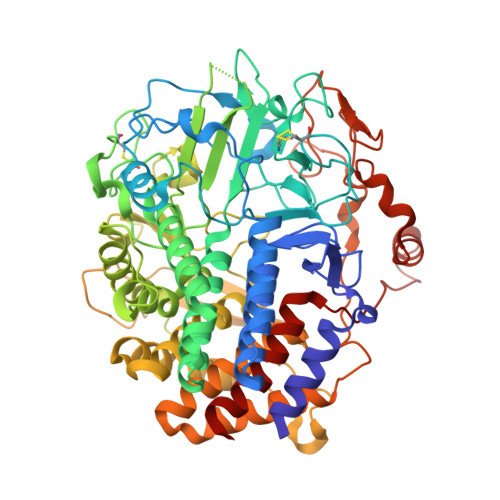Cel48A from Thermobifida fusca: structure and site directed mutagenesis of key residues.
Kostylev, M., Alahuhta, M., Chen, M., Brunecky, R., Himmel, M.E., Lunin, V.V., Brady, J., Wilson, D.B.(2014) Biotechnol Bioeng 111: 664-673
- PubMed: 24264519
- DOI: https://doi.org/10.1002/bit.25139
- Primary Citation of Related Structures:
4JJJ - PubMed Abstract:
Lignocellulosic biomass is a potential source of sustainable transportation fuels, but efficient enzymatic saccharification of cellulose is a key challenge in its utilization. Cellulases from the glycoside hydrolase (GH) family 48 constitute an important component of bacterial biomass degrading systems and structures of three enzymes from this family have been previously published. We report a new crystal structure of TfCel48A, a reducing end directed exocellulase from Thermobifida fusca, which shows that this enzyme shares important structural features with the other members of the GH48 family. The active site tunnel entrance of the known GH48 exocellulases is enriched in aromatic residues, which are known to interact well with anhydroglucose units of cellulose. We carried out site-directed mutagenesis studies of these aromatic residues (Y97, F195, Y213, and W313) along with two non-aromatic residues (N212 and S311) also located around the tunnel entrance and a W315 residue inside the active site tunnel. Only the aromatic residues located around the tunnel entrance appear to be important for the ability of TfCel48A to access individual cellulose chains on bacterial cellulose (BC), a crystalline substrate. Both Trp residues were found to be important for the processivity of TfCel48A on BC and phosphoric acid swollen cellulose (PASC), but only W313 appears to play a role in the ability of the enzyme to access individual cellulose chains in BC. When acting on BC, reduced processivity was found to correlate with reduced enzyme activity. The reverse, however, is true when PASC is the substrate. Presumably, higher density of available cellulose chain ends and the amorphous nature of PASC explain the increased initial activity of mutants with lower processivity.
Organizational Affiliation:
Department of Molecular Biology and Genetics, Cornell University, 458 Biotechnology Building, Ithaca, New York, 14853. mk377@cornell.edu.


























